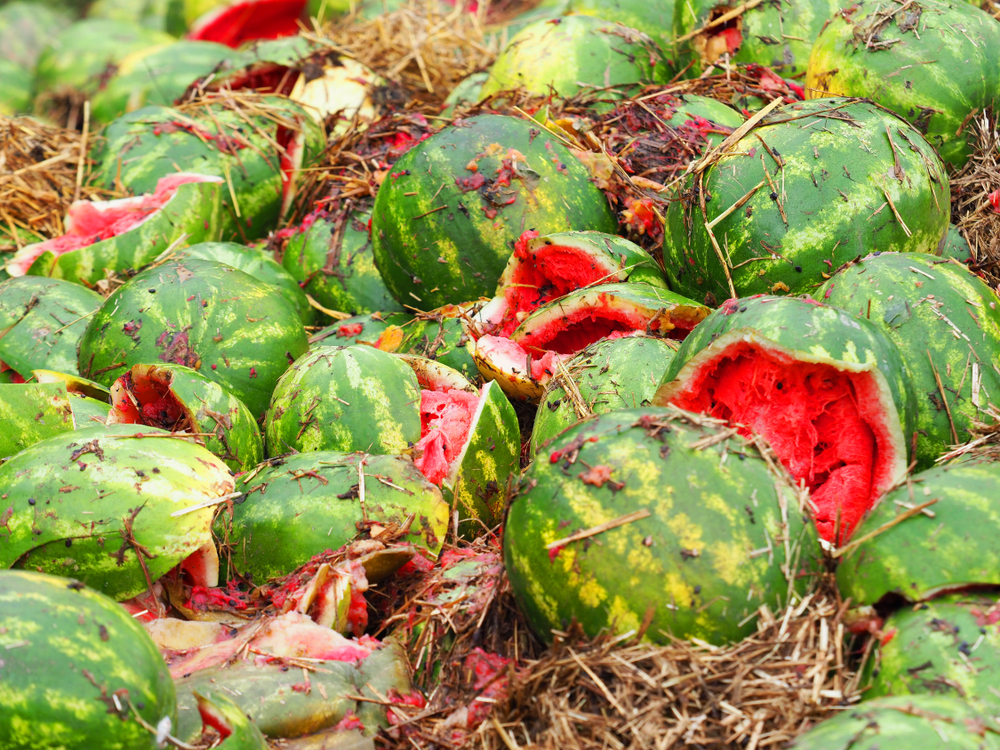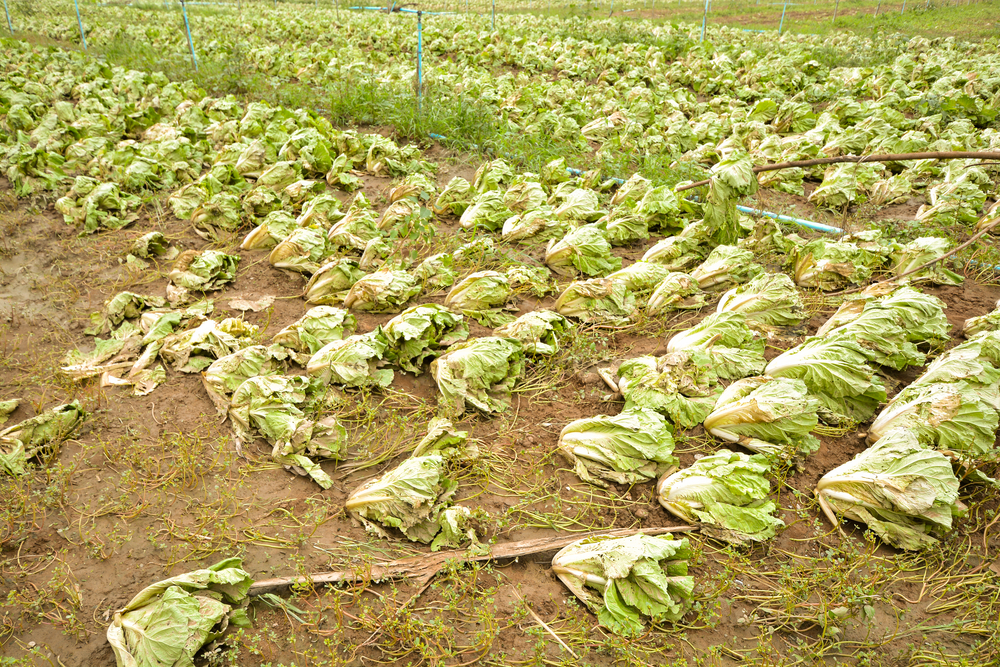Measuring the True Amount of Food Loss on Farms
A free new tool from the World Wildlife Fund helps farmers measure how much crop loss is really happening in their fields.
Measuring the True Amount of Food Loss on Farms
A free new tool from the World Wildlife Fund helps farmers measure how much crop loss is really happening in their fields.

A new tool aims to help farmers reduce on-farm food loss.by ANGHI, Shutterstock.
There are three categories for produce: marketable; edible but not marketable; and inedible. The first category is great, and it’s what every grower strives for. That’s the perfect apple or great-looking squash that comes out of harvest, meeting the highest grading standards. That’s going right to your buyer or retailer.
How about the inedible produce? Well, that’s easy to spot, too. Rotten, infested or otherwise inedible hunks of cauliflower or ripped romaine heads. Those go straight to the compost, or maybe they’re used as animal feed if it’s possible.
The middle category is trickier. What about that tomato that’s just slightly too big or the carrot that twists in on itself? They’re perfectly fine pieces of produce, but not marketable at the grocery store or farmers’ market. Some producers will have a secondary source lined up for those not-quite-good-enough fruits and vegetables. Those carrots can get canned or frozen, the tomatoes get puréed into sauce. But that doesn’t work for all the fruits and vegetables in this category, and it might not be an option for every grower. So what happens to all of that food? Is it considered waste?
Unfortunately, it often is. Leigh Prezkop, senior program officer on the food waste team of the World Wildlife Fund (WWF), says it’s important to accurately measure the amount of food waste that happens on farms. “We always say that what gets measured gets managed,” says Prezkop. To that end, the WWF recently created what it’s calling the Stewardship Index for Specialty Crops Food Loss metric tool to help growers get a handle on the true waste of their farm. It’s free to download and use.
Often, says Prezkop, when growers estimate loss or even use satellite imagery to understand their crop loss, the numbers are not reflective of what’s really going on in the fields. That’s why this tool is designed to get farmers out at ground level to get an up-close look at their yields.
With a few flags, some buckets and a measuring tape, farmers can get more accurate data—and faster. The WWF team worked with seven partner farms to test out the tool and many of the farmers were surprised at the ease of use. “They all seemed to really enjoy the process of going out in the fields in the middle of the day, checking things out after the harvest crews went through. They found it incredibly insightful,” says Prezkop.

The loss figures will change from farm to farm and crop to crop—it’s much more likely to have high loss figures on lettuce than potatoes, for instance. But that’s why it’s important for each grower to figure out their own baseline. From there, growers can take steps to lower their losses and, hopefully, get more out of their harvests.
“Sometimes, it is a matter of a grower deciding that they need to actually harvest one day earlier or that there was a difference in their labor crews from field one and field two that’s worth looking at,” says Prezkop. “It’s such a simple tool, that’s not very technological, [that] can tell the grower so much information.”
That information can also help out policymakers and legislators. WWF has already collected some of its data on food waste so that legislators can consider the numbers when putting together the 2023 Farm Bill. But at a local or regional level, having reliable data like this can help politicians better understand what’s happening in the regions they represent. “Our studies provide the evidence to policymakers to make these changes, especially when they have such strong agenda items to reduce food insecurity, and [meet] their climate goals as well,” says Prezkop.
Part of working to reduce food insecurity falls to legislation and policy. But a huge responsibility falls on the shoulders of retailers, with very specific cosmetic requirements for the produce that they sell. While Prezkop acknowledges that it might be more difficult to get grocery stores or chains to relax their cosmetic requirements and grading systems, collecting this kind of information at the farm level is what will help move that effort forward.
“This is only going to happen if we have year-on-year data collection on farms, to see how much loss is happening. So, then, they can start to predict what might be out there in the fields and in their supply chains for the retailers to purchase at a reduced cost, perhaps,” she says.
With those numbers at hand, it might even be easier to market to consumers. You might be more willing to buy an odd-shaped apple or a gnarled yam if you knew just how many pieces of produce like it got passed over. But those steps will come once farmers can better understand, and mitigate, the waste on their fields. With food loss, the first step is simply knowing where you’re starting from, so you can plot where you’re going.
Follow us

This work is licensed under a Creative Commons Attribution-NoDerivatives 4.0 International License.
Want to republish a Modern Farmer story?
We are happy for Modern Farmer stories to be shared, and encourage you to republish our articles for your audience. When doing so, we ask that you follow these guidelines:
Please credit us and our writers
For the author byline, please use “Author Name, Modern Farmer.” At the top of our stories, if on the web, please include this text and link: “This story was originally published by Modern Farmer.”
Please make sure to include a link back to either our home page or the article URL.
At the bottom of the story, please include the following text:
“Modern Farmer is a nonprofit initiative dedicated to raising awareness and catalyzing action at the intersection of food, agriculture, and society. Read more at <link>Modern Farmer</link>.”
Use our widget
We’d like to be able to track our stories, so we ask that if you republish our content, you do so using our widget (located on the left hand side of the article). The HTML code has a built-in tracker that tells us the data and domain where the story was published, as well as view counts.
Check the image requirements
It’s your responsibility to confirm you're licensed to republish images in our articles. Some images, such as those from commercial providers, don't allow their images to be republished without permission or payment. Copyright terms are generally listed in the image caption and attribution. You are welcome to omit our images or substitute with your own. Charts and interactive graphics follow the same rules.
Don’t change too much. Or, ask us first.
Articles must be republished in their entirety. It’s okay to change references to time (“today” to “yesterday”) or location (“Iowa City, IA” to “here”). But please keep everything else the same.
If you feel strongly that a more material edit needs to be made, get in touch with us at [email protected]. We’re happy to discuss it with the original author, but we must have prior approval for changes before publication.
Special cases
Extracts. You may run the first few lines or paragraphs of the article and then say: “Read the full article at Modern Farmer” with a link back to the original article.
Quotes. You may quote authors provided you include a link back to the article URL.
Translations. These require writer approval. To inquire about translation of a Modern Farmer article, contact us at [email protected]
Signed consent / copyright release forms. These are not required, provided you are following these guidelines.
Print. Articles can be republished in print under these same rules, with the exception that you do not need to include the links.
Tag us
When sharing the story on social media, please tag us using the following: - Twitter (@ModFarm) - Facebook (@ModernFarmerMedia) - Instagram (@modfarm)
Use our content respectfully
Modern Farmer is a nonprofit and as such we share our content for free and in good faith in order to reach new audiences. Respectfully,
No selling ads against our stories. It’s okay to put our stories on pages with ads.
Don’t republish our material wholesale, or automatically; you need to select stories to be republished individually.
You have no rights to sell, license, syndicate, or otherwise represent yourself as the authorized owner of our material to any third parties. This means that you cannot actively publish or submit our work for syndication to third party platforms or apps like Apple News or Google News. We understand that publishers cannot fully control when certain third parties automatically summarize or crawl content from publishers’ own sites.
Keep in touch
We want to hear from you if you love Modern Farmer content, have a collaboration idea, or anything else to share. As a nonprofit outlet, we work in service of our community and are always open to comments, feedback, and ideas. Contact us at [email protected].by Emily Baron Cadloff, Modern Farmer
May 13, 2022
Modern Farmer Weekly
Solutions Hub
Innovations, ideas and inspiration. Actionable solutions for a resilient food system.
ExploreExplore other topics
Share With Us
We want to hear from Modern Farmer readers who have thoughtful commentary, actionable solutions, or helpful ideas to share.
SubmitNecessary cookies are absolutely essential for the website to function properly. This category only includes cookies that ensures basic functionalities and security features of the website. These cookies do not store any personal information.
Any cookies that may not be particularly necessary for the website to function and are used specifically to collect user personal data via analytics, ads, other embedded contents are termed as non-necessary cookies.
It would be nice to discount the misfit produce and make it possible for homebound seniors like me to purchase that produce. If I had a way to travel, I’d love to stock up.